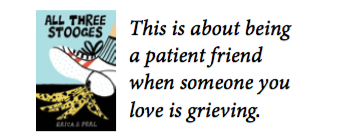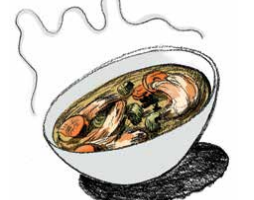
Lilith Talks to Erica Perl about Lifting the Suicide Taboo
When All Three Stooges (Knopf, $22.99) first came across my desk, I saw glancing through it (spoiler here) that in it a dad named Gil dies by suicide. I have to admit I avoided it, because my husband, also named Gil, had died that way. After meeting you when the book won a National Jewish Book Award, I bought a copy for you to sign, and found it a thoroughly engaging and rewarding read.
In light of my own experience, I really appreciated that your middle-grade novel doesn’t presume to speak for—or to—the child whose dad died by suicide, but rather to the friends of that child; that is, to a broader audience of the many who are often deeply affected by such a tragedy. There are doubtless many young readers who experience suicide by a degree or two of separation or, for that matter, other tragedies, and who need to feel seen and have their stories told. Can you share something about your journey preparing to write All Three Stooges?
 Over the years, some of the things that have happened in my life have lodged themselves in my head and heart. When I write, it sometimes shakes them loose and I’m surprised to see them on the page. Early on in my work on the book that would become All Three Stooges, I started thinking about the suicide death of a friend who was also the father of my child’s best friend. I wanted to focus on the ripple effect of a suicide through the lens of a friendship between two boys. To prepare to write the book, I did a lot of research. I read books about suicide, grief, and loss. I interviewed teens who had lost parents to suicide. And I volunteered at a grief camp to better understand the diversity of ways kids grieve.
Over the years, some of the things that have happened in my life have lodged themselves in my head and heart. When I write, it sometimes shakes them loose and I’m surprised to see them on the page. Early on in my work on the book that would become All Three Stooges, I started thinking about the suicide death of a friend who was also the father of my child’s best friend. I wanted to focus on the ripple effect of a suicide through the lens of a friendship between two boys. To prepare to write the book, I did a lot of research. I read books about suicide, grief, and loss. I interviewed teens who had lost parents to suicide. And I volunteered at a grief camp to better understand the diversity of ways kids grieve.
As a reader, I felt so much affection for your narrator, Noah—who perhaps was an example of the “boys who don’t talk” trope. He is always impressed and annoyed with Noa, his homonymic female classmate who runs rings around him in articulateness and sophistication. The families in this story are diverse, just as they are in the real world, in a way we don’t always see in kids’ books: one has divorced parents, one is an interfaith family with two moms, one with a deceased parent and step-parent. How did gender play into your considerations of all these characters?
I started with Noah and Dash, because I knew I wanted to show how strong—and yet how fragile—boys’ friendships can be. Noah’s nemesis, Noa, came next. She’s a girl who’s comfortable doing all the things Noah finds challenging (like: saying the right thing, being patient, and being a good friend to someone who is grieving). And the parental characters fell into place very naturally for lots of reasons. For example, I knew very early on that Noah would be raised by strong women (his two moms and older sister). It has been incredibly gratifying to hear from families who feel seen because of the diversity of Jewish and interfaith families in All Three Stooges.
I’m full of admiration for how you so effectively combined the characters’ love of comedy and humor with such a difficult topic. How did you dare, or rather, how did you know to do this?
Thanks—that means a lot to me! I’ll be honest, it was a bit of a tricky dance. Noah and Dash love comedy, and so does Gil. But, unbeknownst to Noah, Gil struggles with depression—which is something he has in common with many comedians. I tried to use humor to show how laughter can connect and sustain us, and I sought comedy examples to amplify this message as well. I sought to explore the line between sadness and laughter, while making it very clear that there’s nothing funny about the devastating impact of severe depression and suicide.
Many consider suicide a taboo subject. In your essay on Slate, “Alone in the Dark: Why we need more children’s books on suicide and severe depression,” which appeared following some notable celebrity suicides, you wrote “My husband and I didn’t want to explain to our kids why their friend’s dad, the guy who’d made them s’mores on camping trips, was suddenly gone,” and you also survey other books for young readers that touch on this subject that is so often avoided—even by adults. How has this novel been received?
I was extremely honored that All Three Stooges won the 2018 National Jewish Book Award for Children’s Literature and a 2019 Sydney Taylor Award Honor. So, in that respect, the novel has been wonderfully received and celebrated. My only concern is that some people do view suicide as a taboo subject or feel ill-equipped to handle conversations about it. This kind of thinking is counterproductive: talking and reading about mental illness doesn’t produce it. Rather, it destigmatizes mental illness, promotes understanding, and invites those who are struggling to seek treatment and support. Furthermore, All Three Stooges is a book about being a kind, empathetic, and patient friend when someone you love is grieving. It is a book for all children ages 10 and up.
Aside from home and family, this story takes place in a realistic-feeling and upbeat Reform synagogue and Hebrew school setting, with warm, wise rabbis and teachers. Learning that our behavior has consequences is an important part of growing up, and hopefully very much more the point of the bar/bat mitzvah experience than an elaborate party.
Conveying this lesson is taken so seriously here and (another spoiler) that a bar mitzvah celebration could be postponed—not for any reason one might have expected—made so much sense. It also felt like an echo of the suicide theme, where behavior has consequences that can’t just be wished away. There was something so true about how everything was not alright—Noah in his own funk, and frustrated at his bereaved friend’s avoiding him, messes up and behaves unfairly towards him—and yet, life goes on, with all its ups and downs, and continues to be good in surprising ways. How were you able to map out such a very humanly complicated story?
As I was plotting this novel, I felt very sorry for Noah, because, though he makes some poor choices, his heart is clearly in the right place. So, I was very tempted to end the book differently, and give him the results he wants: having all his misdeeds forgiven and becoming a bar mitzvah as scheduled. But the more I tried to write that ending, the more it felt wrong. Deciding not to give Noah the result he craved allowed me to take him down a path that was more honest and, because of that, ultimately hopeful. Writing Noah’s journey this way also allowed him to discover something that I believe: even in times of profound loss, love and laughter endure.




